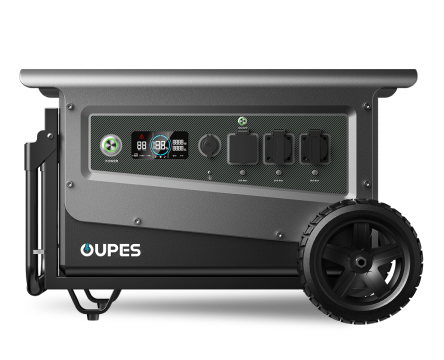
Overview
Wind and solar are two of the fastest-growing renewable energy sources in the world. But when comparing them, many consumers and homeowners ask the same question: Which generates more power—wind or solar? Using authoritative data from the International Energy Agency (IEA), the U.S. Energy Information Administration (EIA), and NREL (National Renewable Energy Laboratory), this article examines real-world performance, average output, efficiency, and ideal use scenarios.
Although wind power leads in large utility-scale energy production, solar excels in accessibility, scalability, and portable applications such as solar generators and power stations from brands like OUPES.
Wind vs. Solar: The Basics
Wind Power
Wind power is generated using wind turbines that convert kinetic energy from air movement into electricity. Large utility-scale wind farms can generate massive amounts of power, especially in regions with steady winds.
Solar Power
Solar power is generated using photovoltaic (PV) panels that convert sunlight into electricity. Solar works on homes, commercial buildings, and portable devices like solar generators and solar-powered power stations.
Which Generates More Power?
Utility-Scale Comparison
At the utility scale, wind generally generates more power than solar because:
- Wind turbines can operate day and night
- Wind farms often span vast land areas
- Individual turbines can exceed 5 MW (and some exceed 10 MW)
By contrast, solar farms require daylight and have limited output during cloudy or winter months.
U.S. Annual Power Generation (EIA, 2023)
- Wind: ~430 TWh per year
- Solar: ~240 TWh per year
This means wind generated nearly 80% more power than solar at the national utility scale.
Residential or Small-Scale Comparison
For homeowners, solar usually generates more reliable power because:
- Solar panels work in nearly any location with sunlight
- Wind turbines require minimum wind speeds and zoning approval
- Residential wind turbines are costly and often inefficient without strong wind resources
As a result, solar is the dominant choice for residential and portable power applications.
Wind vs. Solar Power Comparison
| Category | Wind Power | Solar Power |
|---|---|---|
| Typical Utility-Scale Output | 2–10+ MW per turbine | 0.3–0.6 MW per acre (solar farm) |
| Annual U.S. Generation (2023) | ~430 TWh | ~240 TWh |
| Availability | Can run 24/7 but depends on wind | Daylight only, depends on sunlight |
| Best For | Utility-scale, rural areas, coastal regions | Homes, RVs, off-grid cabins, portable power |
| Installation | Complex, requires permits and open land | Simple installation on roofs or ground |
| Portable Options | None practical | Solar generators, foldable panels, power stations |
Based on these factors, wind generates more power at the utility scale, but solar offers broader accessibility for everyday consumers, homeowners, and portable energy needs.
Factors That Influence Power Generation
1. Weather & Climate
Wind requires consistent airflow, while solar depends on sunlight intensity. Regions like the Midwest and Texas excel with wind, while the Southwest leads with solar potential.
2. Geographic Limitations
Wind turbines require large open areas. Solar panels can be installed almost anywhere—including rooftops.
3. Equipment Size & Infrastructure
Utility wind turbines can exceed 300 feet in height. Solar systems scale much easier, from small portable panels to multi-megawatt solar farms.
4. Cost Trends
Both wind and solar have dropped dramatically in cost over the past 10 years. However, solar remains more affordable for individual consumers.
5. Energy Storage
Solar pairs naturally with battery storage systems, including portable power stations and solar generators. Wind also uses storage, but typically at the utility scale.
Best Use Cases for Wind and Solar
When Wind Power Is Best
- Large utility companies generating gigawatt-scale power
- Rural or coastal regions with strong wind corridors
- Industrial-scale renewable energy projects
When Solar Power Is Best
- Homeowners needing roof-mounted clean energy
- RV travelers and off-grid cabins
- Emergency backup power during outages
- Portable applications like solar generators
Why Solar Dominates Portable Power
Wind turbines are not practical for mobile or compact use. Solar, however, can be folded, mounted, or integrated directly into portable power stations. Brands like OUPES offer solar generators and portable batteries ideal for camping, van life, and emergency preparedness.
The Role of Portable Solar Generators
Reliable Energy Anywhere
Portable solar generators allow users to capture solar energy anytime and store it for later use. They’re widely used for outdoor travel, remote work, RV living, disaster relief, and home emergency backup.
Charging Flexibility
Portable power stations can be charged by:
- Solar panels
- AC wall outlets
- Car charging
Eco-Friendly Backup Power
Unlike gas generators, solar generators run quietly, require no fuel, and produce zero emissions—making them ideal for both indoor and outdoor use.
FAQ
1. Does wind generate more power than solar?
At the utility level, yes. Wind currently generates more total electricity in the U.S. than solar. However, solar is more accessible for residential and portable use.
2. Which is more reliable?
Wind can operate day and night, but only with sufficient wind resources. Solar is very predictable but depends on daylight.
3. Which is more cost-effective for homes?
Solar is usually far more cost-effective for homeowners. Residential wind turbines require high wind speeds and often face zoning restrictions.
4. Can portable wind generators replace portable solar?
No. Portable wind turbines are inefficient and impractical. Solar is the standard for mobile power solutions.
5. How do solar generators fit into renewable energy?
Solar generators offer an easy way to use solar energy anywhere without rooftop installation, making renewable power accessible to renters, travelers, and emergency-preparedness users.




























